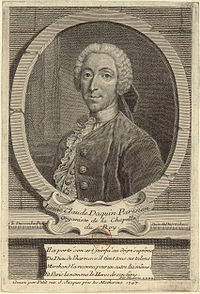
Louis-Claude Daquin (or D'Aquino, d'Aquin, d'Acquin; July 4, 1694 – June 15, 1772) was a French composer, writing in the Baroque and Galant styles. He was a virtuoso organist and harpsichordist.
Life
Louis-Claude Daquin was born in Paris to a family originating from Italy, where his great-great-grandfather took the name D'Aquino after converting to Catholicism in the town of Aquino. Louis-Claude's parents were Claude Daquin, a painter, and Anne Tiersant, a grand-niece of Rabelais. One of Louis-Claude's grand-uncles was a professor of Hebrew at the Collège de France, and another was the principal physician of King Louis XIV.
Daquin was a musical child prodigy. He performed for the court of Louis XIV at the age of six. He was for a while a pupil of Louis Marchand. At the age of 12, he became organist at the Sainte-Chapelle, and in the following year took a similar post at the Church of Petit Saint Antoine. In 1722 he married Denise-Thérèse Quirot.
Louis-Claude Daquin never lacked for work as an organist. In 1727 he was appointed organist at the Church of Saint Paul in Paris, ahead of Jean-Philippe Rameau who was also a candidate. Five years later, Daquin succeeded his teacher Marchand as organist at the Church of the Cordeliers. In 1739 he became organist to King Louis XV at the Chapelle Royale. In 1755 he was made titular organist at Notre-Dame Cathedral, succeeding Guillaume-Antoine Calvière.
By reputation a dazzling performer at the keyboard, Daquin was courted by the aristocracy, and his great expertise at the organ drew large crowds to hear him. He was known for his "unfaltering precision and evenness" at both the harpsichord and organ.
Compositions
At the age of eight, he conducted his own choral work Beatus Vir.
Daquin's surviving music includes four harpsichord suites, the c.1757 Nouveau livre de noëls for organ and harpsichord (settings of Christmas carols, which include some of his harpsichord improvisations), a cantata, an air à boire, and manuscripts of two Masses, a Te Deum, a Miserere, and Leçons de Ténèbres. Among the most famous of his works are the Swiss Noël (Noël Suisse, No. XII from his Nouveau livre) and The Cuckoo (Le coucou, from his 1735 harpsichord suite, Pièces de clavecin, Troisième Suite).
Among technical innovations, his Trois cadences for harpsichord contains a triple trill.
The Noëls
For Daquin's twelve published Noëls, French organist Jean-Claude Duval has sourced the following old texts:
- I. Noel, sur les jeux d'Anches sans tremblant: «À la venuë de Noël»
- II Noel, en dialogue, Duo, Trio, sur le cornet de récit, les tierces du positif et la pédalle de Flûte: «Or nous dites Marie»
- III Noel en Musette, en Dialogue, et en Duo: «Une bergère jolie»
- IV Noel en Duo, sur les jeux d'Anches, sans tremblant: «Noël, cette journée»
- V Noel en Duo: «Je me suis levé» or «Ô jour glorieux»
- VI Noel, sur les jeux d'Anches, sans tremblant, et en Duo: «Qu'Adam fut un pauvre homme»
- VII Noel, en Trio et en Dialogue, le cornet de récit de la main droitte, la Tierce du Positif de la main gauche: «Chrétiens qui suivez l'Église»
- VIII Noel Étranger, sur les jeux d'anches sans tremblant et en Duo: «?» (foreign carol, perhaps Italian)
- IX Noel, sur les Flûtes: «Noël pour l'amour de Marie» and «Chantons, je vous prie»
- X Noel, Grand jeu et Duo: «Quand Dieu naquit à Noël» or «Bon Joseph, écoutez-moi»
- XI Noel, en Récit en Taille, sur la Tierce du Positif, avec la Pédalle de Flûte, et en Duo: «Une jeune Pucelle»
- XII Noel Suisse, Grand jeu, et Duo: «Il est un p'tit l'ange» or «Ô Dieu de clémence»
Media

Noël No. X
Problems playing this file? See media help.

Le Coucou
Problems playing this file? See media help.
Discography
- Louis Claude Daquin, l'œuvre intégrale pour orgue / Louis Claude Daquin, Complete organ works. Marina Tchebourkina at the Great Organ of the Royal Chapel of the Palace of Versailles. — Natives, 2004. (EAN 13 : 3760075340049)
References
- Sadie, Stanley, ed. (1980). "Louis-Claude Daquin". The New Grove Dictionary of Music and Musicians. London: Macmillan. ISBN 1561591742.
- Burrows, John, ed. (2005). "Louis-Claude Daquin". Classical Music. New York: DK Publishing. ISBN 0756609585.
- Sendrey, Alfred (1970). The Music of the Jews in the Diaspora. New York: Thomas Yoseloff. ISBN 0498066479.
- Peumery, Jean-Jacques (1996). "The disgrace of Antoine Daquin, first physician of Louis XIV". Vesalius. 2 (2): 79–85. PMID 11618769.
- Daquin, Louis-Claude (c.1757). Nouveau Livre de Noëls pour l'orgue et le clavecin. 1st ed. Paris: Labassée. Retrieved December 19, 2014. (first half only)
- Duval, Jean-Claude (2012). "Paroles des Noëls de Louis-Claude Daquin" (PDF). Archived from the original (PDF) on November 29, 2014. Retrieved November 20, 2014.
External links
- Free scores by Louis-Claude Daquin at the International Music Score Library Project (IMSLP)
- Click these links to listen to three Noëls on the organ:
- 1694 births
- 1772 deaths
- Composers from Paris
- French male classical composers
- French Baroque composers
- Composers for pipe organ
- French classical organists
- Cathedral organists
- French harpsichordists
- Child classical musicians
- 18th-century French keyboardists
- 18th-century French classical composers
- 18th-century French male musicians
- French male classical organists